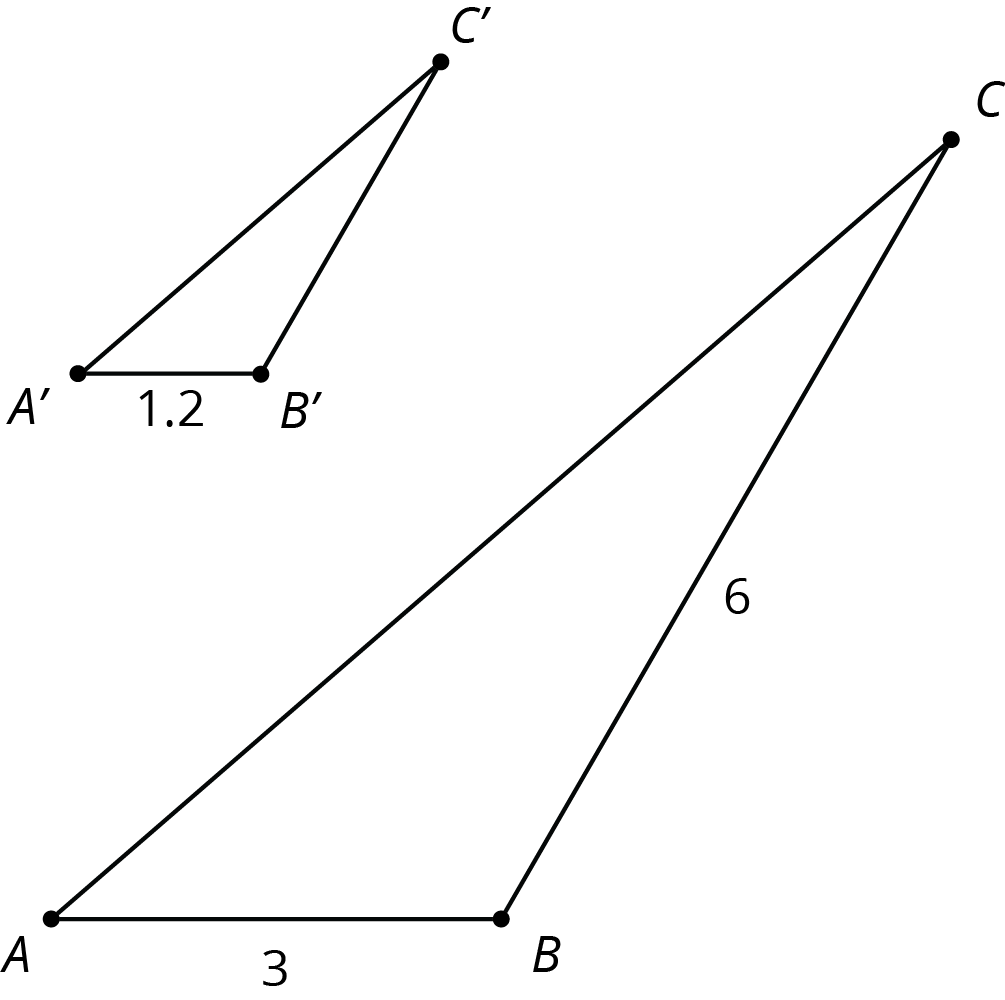Lesson 9
Side Length Quotients in Similar Triangles
9.1: Two-three-four and Four-five-six (5 minutes)
Warm-up
Two sets of triangle side lengths are given that do not form similar triangles. Students should recognize that there is no single scale factor that multiplies all of the side lengths in one triangle to get the side lengths in the other triangle.
Launch
Give 2 minutes of quiet work time followed by a whole-class discussion.
Student Facing
Triangle \(A\) has side lengths 2, 3, and 4. Triangle \(B\) has side lengths 4, 5, and 6. Is Triangle \(A\) similar to Triangle \(B\)?
Student Response
For access, consult one of our IM Certified Partners.
Anticipated Misconceptions
Students might think that adding the same number to each side length will result in similar triangles. Drawing a picture helps students see why this is not true.
Activity Synthesis
Ask students how they can tell without drawing a diagram. Make sure students understand that the triangles can not be similar because you can’t apply the same scale factor to each side of one triangle to get the corresponding sides of the other triangle.
Display diagrams of the triangles for visual confirmation.
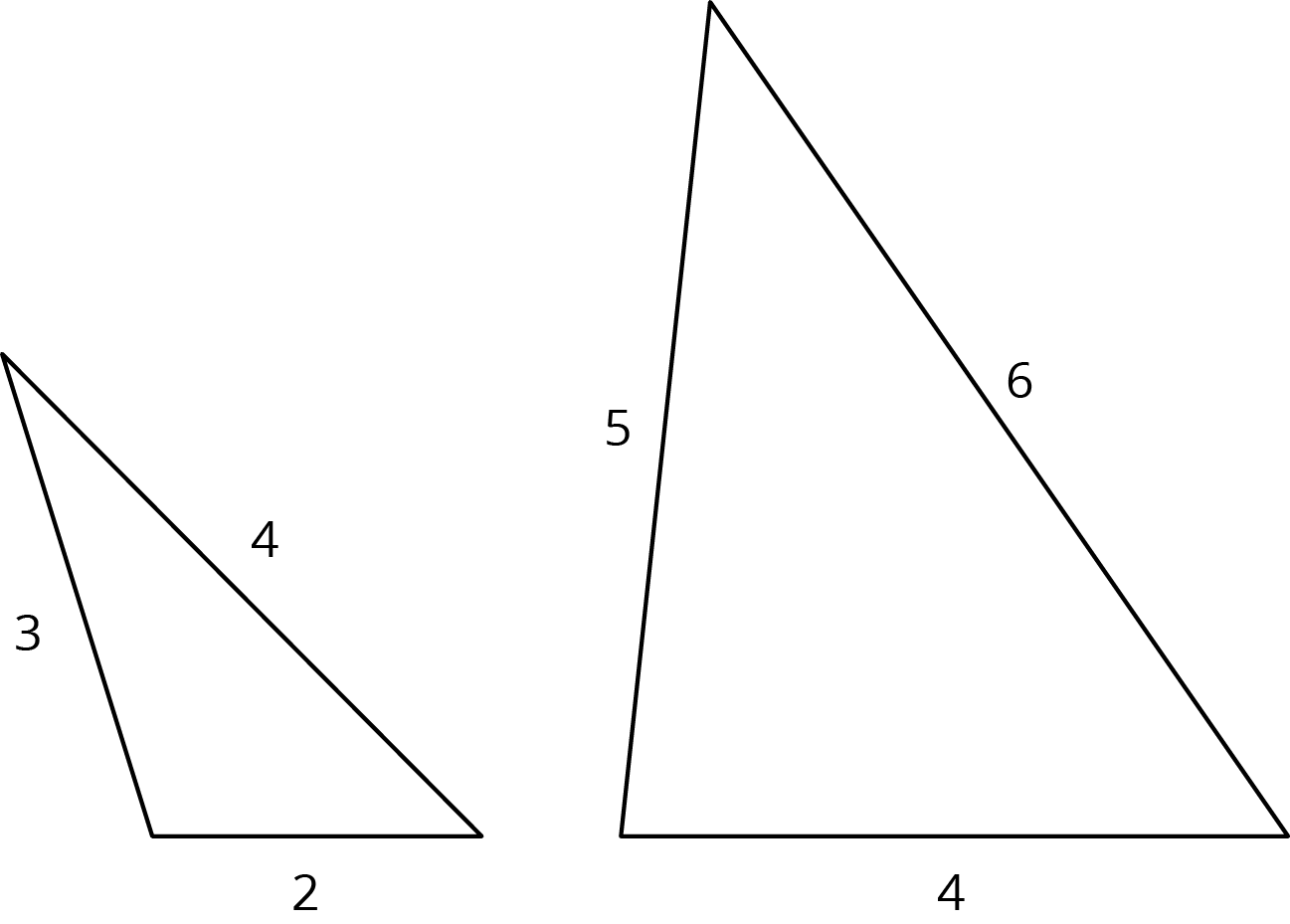
9.2: Quotients of Sides Within Similar Triangles (15 minutes)
Activity
In previous lessons, students have seen that corresponding side lengths of similar polygons are proportional. That is, the side lengths in one polygon can be calculated by multiplying corresponding side lengths in a similar polygon by the same scale factor. This activity explores ratios of side lengths within triangles and how these compare for similar triangles. If \(a\) and \(b\) are the side lengths of a triangle then the corresponding side lengths of a similar triangle have lengths \(sa\) and \(sb\) for some positive scale factor \(s\). This means that the ratios \(a:b\) and \(sa:sb\) are equivalent.
As students work, circulate to make sure that students have the correct values in the table, and address any misconceptions with individual groups as needed. Also watch for students who look to explain why the internal ratios of corresponding side lengths of similar triangles are equivalent and invite them to share their thinking during the discussion.
Launch
Arrange students in groups of 3. Assign one of the columns in the second table to one student in each group. Tell students, “Each group is going to compare side lengths in similar triangles. Work for 5 minutes by yourself. Then compare your findings with your partners.”
Supports accessibility for: Memory; Conceptual processing
Student Facing
Triangle \(ABC\) is similar to triangles \(DEF\), \(GHI\), and \(JKL\). The scale factors for the dilations that show triangle \(ABC\) is similar to each triangle are in the table.
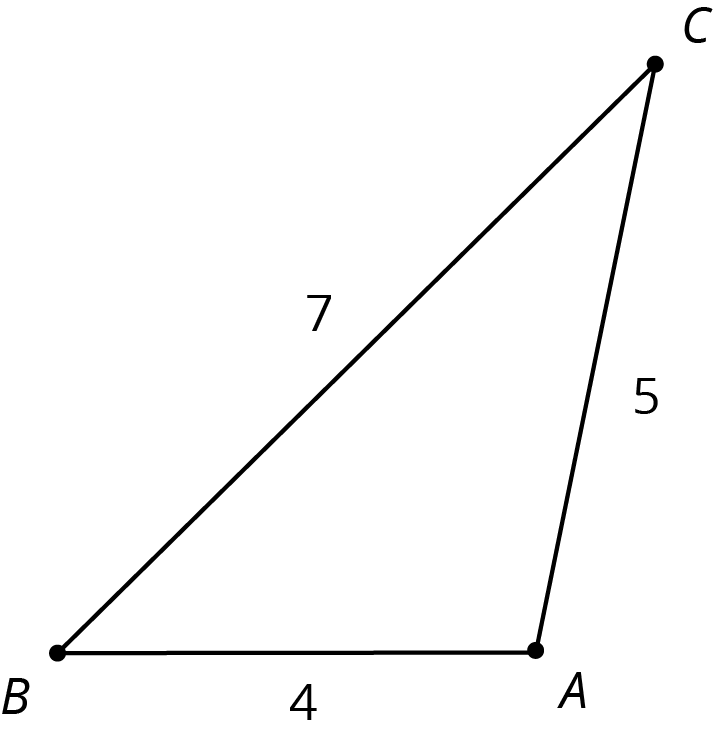
-
Find the side lengths of triangles \(DEF\), \(GHI\), and \(JKL\). Record them in the table.
triangle scale factor length of
short sidelength of
medium sidelength of
long side\(ABC\) 1 4 5 7 \(DEF\) 2 \(GHI\) 3 \(JKL\) \(\frac{1}{2}\) -
Your teacher will assign you one of the three columns. For all four triangles, find the quotient of the triangle side lengths assigned to you and record it in the table. What do you notice about the quotients?
triangle (long side) \(\div\) (short side) (long side) \(\div\) (medium side) (medium side) \(\div\) (short side) \(ABC\) \(\frac{7}{4}\) or 1.75 \(DEF\) \(GHI\) \(JKL\) - Compare your results with your partners’ and complete your table.
Student Response
For access, consult one of our IM Certified Partners.
Student Facing
Are you ready for more?
Triangles \(ABC\) and \(DEF\) are similar. Explain why \(\frac{AB}{BC} = \frac{DE}{EF}\).
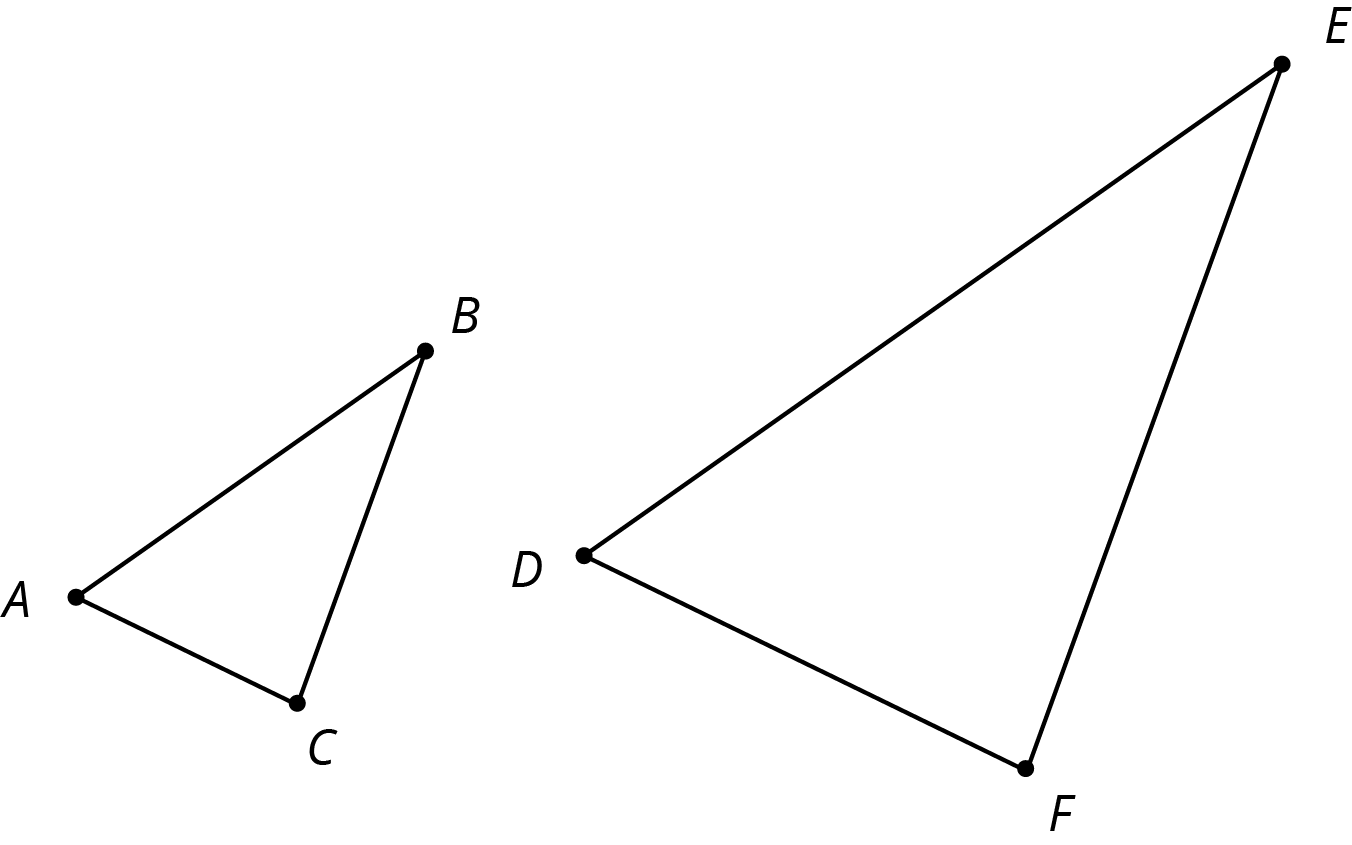
Student Response
For access, consult one of our IM Certified Partners.
Anticipated Misconceptions
If students find quotients in fraction form, they need to recognize that the fractions are equivalent.
Activity Synthesis
The main takeaway from this activity is that quotients of corresponding side lengths in similar triangles are equal. Ask students for the triangles examined what the value of (medium side) \(\div\) (long side) would be? For the original triangle, it would be \(\frac{5}{7}\), and students can check that this is the same value for the other triangles.
Ask students if they think the value of (medium side) \(\div\) (long side) would be \(\frac{5}{7}\) for any triangle similar to \(ABC\). Ask them to explain why. Help them to see that a triangle similar to \(ABC\) will have side lengths \(4s\), \(5s\), and \(7s\) for some (positive) scale factor \(s\). The medium side divided by the long side will be \(5s \div 7s = \frac{5s}{7s} = \frac57\).
Design Principle(s): Optimize output (for explanation)
9.3: Using Side Quotients to Find Side Lengths of Similar Triangles (15 minutes)
Activity
In this activity, students calculate side lengths of similar triangles. They can use the scale factor between the similar triangles, studied in depth in previous lessons. Or they can look at internal ratios between corresponding side lengths within the triangles, introduced in the previous lesson. Students need to think strategically about which side lengths to calculate first since there are many missing values. As they discover more side lengths, this opens up more paths for finding the remaining values.
As students work, monitor for students who:
- Use scale factors between triangles.
- Notice that the long side is twice the short side in \(GHI\) and use that to find \(c\), \(d\), or \(e\).
- Notice that the long sides are equal in \(ABC\) and use that to find \(h\), \(d\), or \(e\).
Select students who use different strategies to find side lengths to share during the discussion.
Launch
Tell students, “There are many ways to find the values of the unknown side lengths in similar triangles. Use what you have learned so far.” Give students 5 minutes of quiet work time followed by 5 minutes small group discussion and then a whole-class discussion.
Supports accessibility for: Visual-spatial processing
Student Facing
Triangles \(ABC\), \(EFD\), and \(GHI\) are all similar. The side lengths of the triangles all have the same units. Find the unknown side lengths.
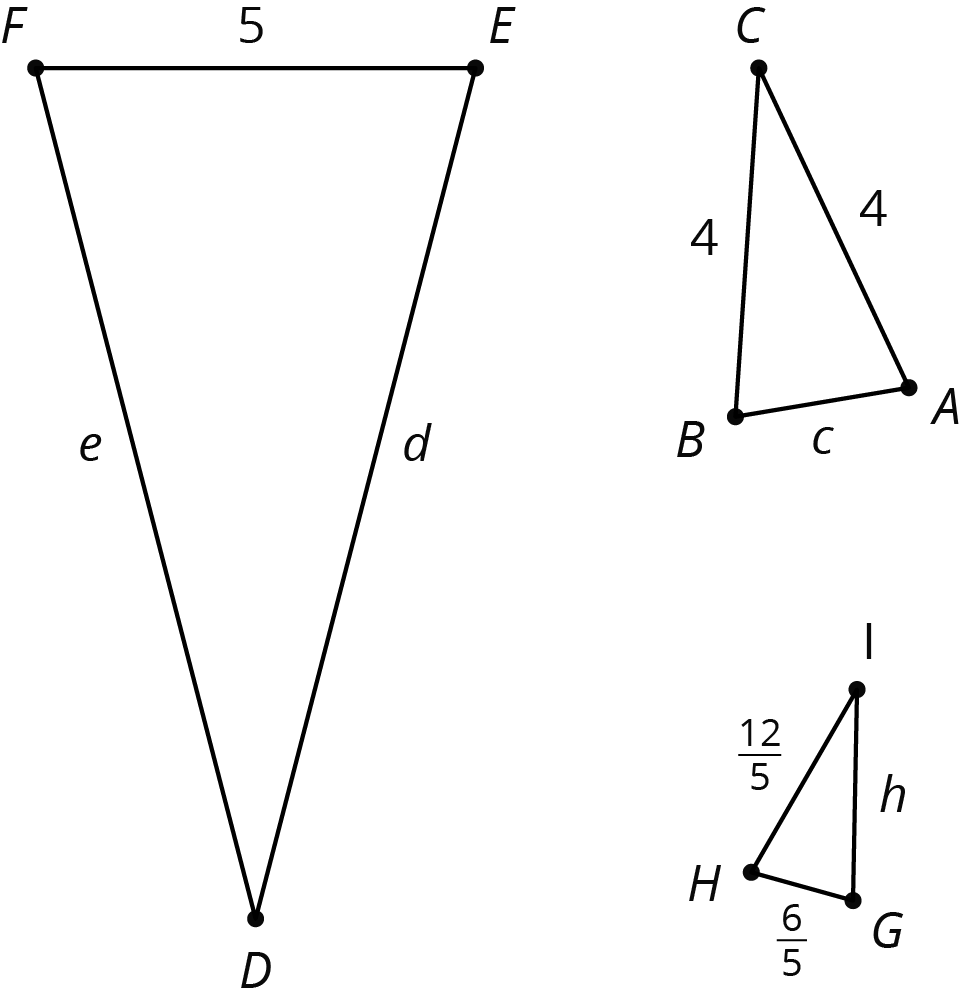
Student Response
For access, consult one of our IM Certified Partners.
Anticipated Misconceptions
If students have trouble locating corresponding sides, suggest that they use tracing paper so they can rotate and or translate them. Another technique is to color corresponding side lengths the same color. For example, they could color \(AB\), \(EF\), and \(GH\) all red.
Activity Synthesis
Ask selected students to share the following strategies:
- using (external) scale factors to move from one triangle to another
- using quotients of corresponding side lengths within the triangles (internal scale factors)
Both methods are efficient and the method to use is guided by what information is missing and the numbers involved in the calculations. For example, if \(h\) is the first missing value we find, then comparing with triangle \(ABC\) and using internal scale factors is appropriate. To find \(c\), again we can compare \(ABC\) and \(GHI\) and internal scale factors are appropriate again because \(\frac{6}{5}\) is half of \(\frac{12}{5}\) whereas comparing \(\frac{12}{5}\) and \(4\) is more involved (the scale factor is \(\frac{5}{3}\) from \(\triangle GHI\) to \(\triangle ABC\)).
Ask students to articulate how they knew which sides of the similar triangles correspond. Make sure to make the following reasoning pathways explicit for all:
- Triangle \(ABC\) has two equal side lengths, so the other two triangles will as well. This insight is efficient for finding \(h\).
- One side of triangle \(GHI\) is twice the length of another side, so this will be true of the other triangles as well. This insight is helpful for finding \(c\), \(d\), and \(e\).
Emphasize that there are many different relationships that can be used to find side lengths of similar triangles.
Design Principle(s): Support sense-making, Optimize output (for comparison)
Lesson Synthesis
Lesson Synthesis

Sometimes both methods for calculating missing side lengths are equally effective. For \(EF\), we can notice that it is \(\frac{5}{2}\) the length of the corresponding side \(BC\) so that’s 7.5. Or we can notice that it is \(\frac{3}{2}\) the length of \(DE\), again 7.5 (\(\frac{3}{2}\) is the quotient of the corresponding sides \(BC\) and \(AB\) in \(\triangle ABC\)).
9.4: Cool-down - Similar Sides (5 minutes)
Cool-Down
For access, consult one of our IM Certified Partners.
Student Lesson Summary
Student Facing
If two polygons are similar, then the side lengths in one polygon are multiplied by the same scale factor to give the corresponding side lengths in the other polygon.
For these triangles the scale factor is 2:
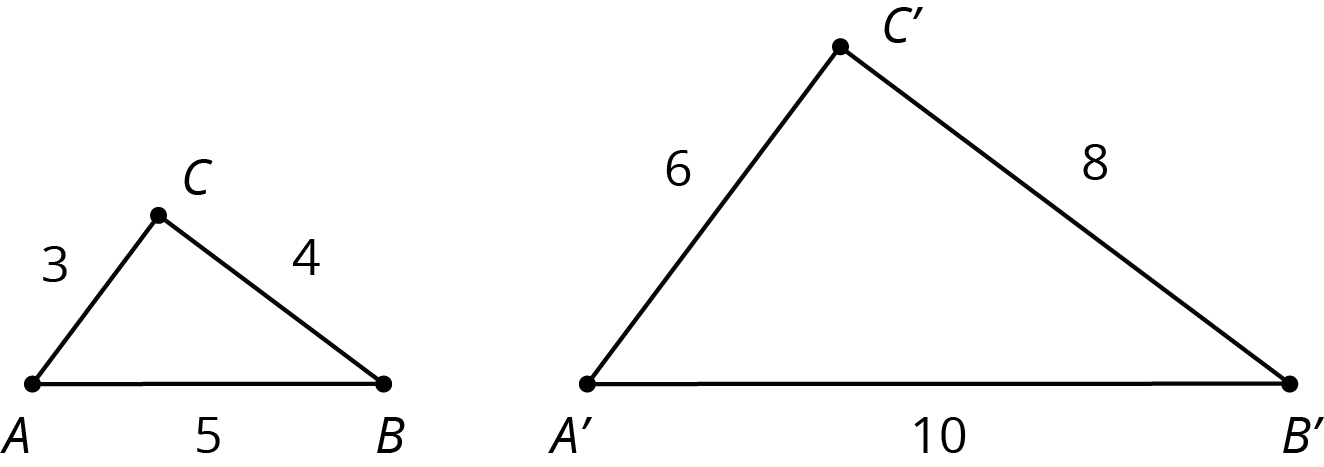
Here is a table that shows relationships between the short and medium length sides of the small and large triangle.
| small triangle | large triangle | |
|---|---|---|
| medium side | 4 | 8 |
| short side | 3 | 6 |
| (medium side) \(\div\) (short side) | \(\frac{4}{3}\) | \(\frac{8}{6} = \frac{4}{3}\) |
The lengths of the medium side and the short side are in a ratio of \(4:3\). This means that the medium side in each triangle is \(\frac43\) as long as the short side. This is true for all similar polygons; the ratio between two sides in one polygon is the same as the ratio of the corresponding sides in a similar polygon.
We can use these facts to calculate missing lengths in similar polygons. For example, triangles \(A’B’C’\) and \(ABC\) shown here are similar. Let's find the length of segment \(B’C’\).
In triangle \(ABC\), side \(BC\) is twice as long as side \(AB\), so this must be true for any triangle that is similar to triangle \(ABC\). Since \(A'B'\) is 1.2 units long and \(2\boldcdot 1.2 = 2.4\), the length of side \(B’C’\) is 2.4 units.
